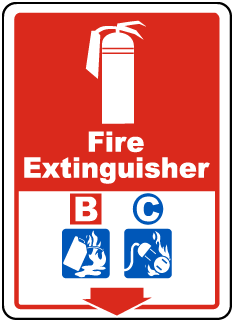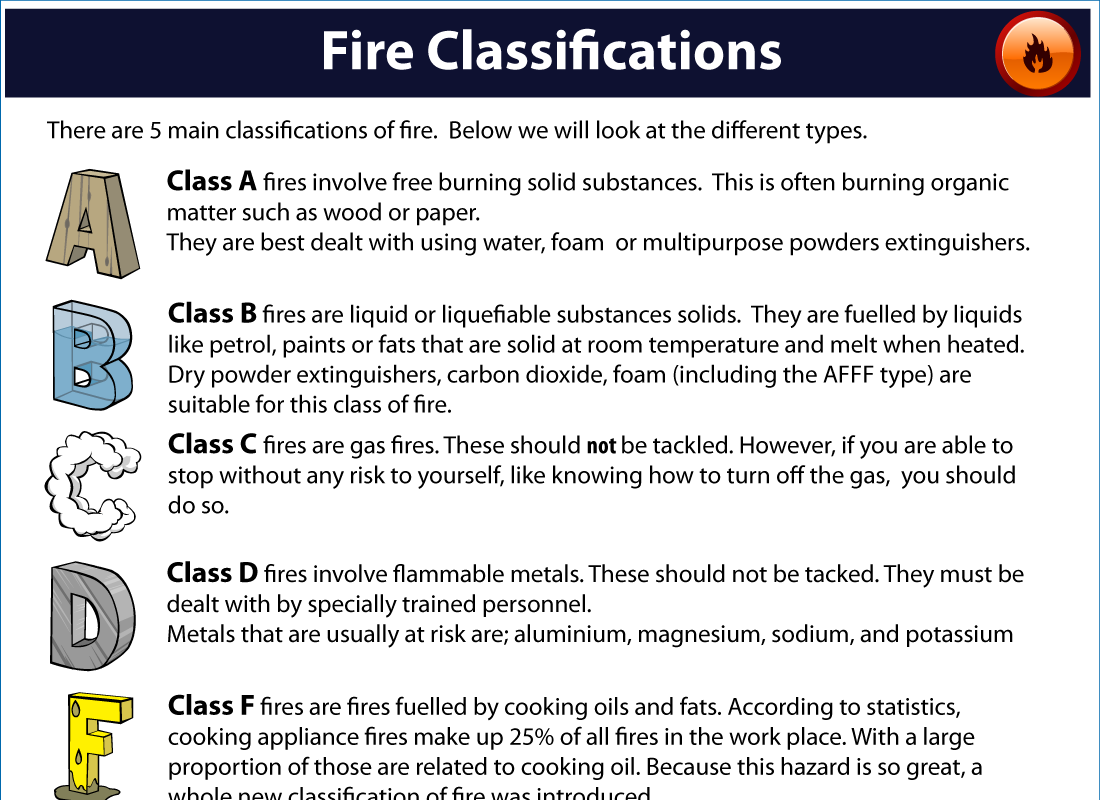43 where are the labels of classification on the fire extinguisher
Fire Extinguisher label of classification Fire Extinguisher label of classification,Fire Triangle,Fire Tetrahedron,Classification of Fire,CO2 Fire extinguisher,DCP Fire extinguisher Fire Extinguisher Classes And Their Colour Codes - HSEWatch EXTINGUISHER CLASS OF FIRE COLOUR CODE. Water A RED. Foam A & B CREAM. DCP A, B & C BLUE. CO 2 B & C BLACK. Wet Chemical F -. Dry Powder D -. Water fire extinguisher: These fire extinguishers are more effective in fighting class A fire; fire involving solid fuels. There are four different types of water extinguishers: water jet, water spray ...
Classes of Fires and Types of Fire Extinguishers In addition to classes of fires, we can also identify different types of extinguishers. Fire extinguishers are classified as types A, ABC, BC or K. It is important to identify the right type of extinguisher for the fire burning. If the wrong type of fire extinguisher is used, it may cause electrical shock or spread the fire.
Where are the labels of classification on the fire extinguisher
5 types of fire extinguishers: A guide to using the right class There are five main types of fire extinguisher, and we'll go into more detail on each below. These are: Water, water mist or water spray fire extinguishers. Foam fire extinguishers. Dry Powder - standard or specialist fire extinguishers. Carbon Dioxide ('CO2') fire extinguishers. Is It Illegal To Remove a Fire Extinguisher Label? - SelectSafety What Info Do Fire Extinguisher Labels Contain? Fire extinguisher labels usually contain the following information: Instructions for use; The type of fire extinguisher it is (class A, B, C, etc.) Types of fires to use the extinguisher on; Types of fire NOT to use the extinguisher on; Contents (foam, water, CO2, etc.) ANSI / UL standards that it ... Fire extinguisher types: How to choose the right fire extinguisher Fire extinguisher types and uses, Water fire extinguishers, Water mist extinguishers, Water spray fire extinguishers, Foam extinguishers, Dry Powder, Carbon Dioxide ('CO2'), Five main types of fire extinguishers, Each of the different types of fire extinguisher is suitable for different fire classes. It is important that you purchase the right fire extinguisher for your needs.
Where are the labels of classification on the fire extinguisher. Fire Classes and Fire Extinguisher Ratings | TRADESAFE While Class K fire extinguishers are not covered by OSHA fire extinguisher requirements in 29 CFR 1910.157, they are nonetheless worth having in certain facilities. According to National Fire Protection Association (NFPA) recommendations, there should be a travel distance of 30 ft (9.1 m) or less between a hazard and a Class K fire extinguisher. A Guide To The Different Types Of Fire Extinguishers - UK Safety Store Foam Fire Extinguisher use While more versatile, foam fire extinguishers are liquid based and work similarly to water, cooling and smothering the fuel of a fire. Label colour: Cream Suitable for: Class A (combustible materials) fires Class B (flammable liquids) fires Fire Extinguisher Classes, Explained | SecurityNerd Class C fire extinguishers. Carbon Dioxide: Co2 extinguishers work well for Class C fires as they smother the fire and deprive it of oxygen. Dry Chemical: The regular dry chemical extinguisher is well-rated for class C and B fires. Clean agent: Like dry chemical extinguishers, the clean agents interrupt the fire triangle's chemical reaction. Fire Extinguisher Inspection Checklist | Download PDF | SafetyCulture A fire extinguisher checklist is a tool used by safety officers and facility managers when conducting scheduled fire extinguisher inspections. Also called a fire extinguisher inspection form, it allows inspectors to record details about the fire extinguishers such as label and maintenance tags. Other observations could be documented as well ...
What Do the Letters and Numbers Mean on Your Fire Extinguisher? Year to date made - Fire Extinguisher. The numbers you might see accompanying the letter class of a fire extinguisher refer to the extinguishers size rating for class A and B fires. Other classes don't have such a rating. For class A fires, the number corresponds to its effectiveness relative to 1 ¼ gallons of water. Fire extinguisher types and fire classes in Australia Whilst there are 5 main types of fire extinguisher, there are different versions of Dry Powder Chemical extinguishers The types of fire extinguisher are: - Water. - Foam. - Dry Powder - ABE. - Dry Powder - BE. - Carbon Dioxide ('CO2') - Wet Chemical. There is no one extinguisher type which works on all classes of fire. Different Types of Fire Extinguisher - Total Safe UK Different Types of Fire Extinguisher 10 April 2022 22 June 2022 Kirsty When you are in a building, you will have noticed that not all of their fire extinguishers are the same - the labels on them are different colours so the fire marshal can easily identify the different types of fire extinguisher and establish which one of them is necessary ... Fire Extinguisher Types and What They Are Used For The most common fire extinguisher type in incidents of Class B-type fires. Consider, as foam extinguishers are water-based, these types of extinguishers can be used on Class A-type fires, also. Much like water extinguishers, the foam variety can be used to put out fires caused by organic material such as cardboard, coal and fabrics.
Different Types of Fire Extinguishers and How to Use Them Put yourself within the "effective range" that is marked on the extinguisher's label. For most dry chemical ABC fire extinguishers, this distance will be about 6 to 8 feet. Hold the extinguisher upright. Discharge the extinguisher within its effective range using the P.A.S.S. technique (pull, aim, squeeze, sweep). What Are The Different Fire Extinguisher Types? - EvolutionFire A dry powder fire extinguisher is extremely versatile, suitable for use on Class A (combustible materials), Class B (flammable liquids) and Class C (flammable gases) fires. It's, for this reason, they're known as 'ABC' extinguishers. This extinguisher smothers fires by producing a thick barrier between the fuel and the source of oxygen. What Is The CO2 Fire Extinguisher Label Colour? - TGC Network Ltd Carbon Dioxide (CO2) Extinguishers - Label Colour: Black. CO2 extinguishers have black labels and are mainly used to put out electrical fires, while they are also the most common type of extinguisher found in server rooms. They also put out fires that are classified as Class B (flammable liquid). - Flammable liquids such as paint, gasoline ... What Type of Fire Extinguisher Do I Need? - SelectSafety.net The type of fire extinguisher you need depends on the type of fire you need to put out: Class A Fires - fires caused by combustibles like wood, metal, cloth, paper, rubber, and plastics. Class B Fires - fires caused by flammable liquids like gasoline and grease. Class C Fires - fires caused by energized electrical equipment or wiring.
Fire Extinguisher Types - CPD Online College This classification then gives us information on the type of fire extinguisher we should use to put out the flames. Not all fires require the same type of extinguisher and the correct type has to be used for each blaze. Different fire extinguisher types are used to differentiate the best ones to use on the type of fire you are confronting. Class A
The ABCs, D, and Ks of Fire Extinguishers - Occupational Health & Safety Also located on the fire extinguisher label is the UL rating. The UL rating is broken down into Class A and Class B:C ratings. Numerical ratings allow you to compare the relative extinguishing ...
Clause 11.6 Fire Safety Serial Labels and Declarations of Compliance - SCDF 11.6.3 Traceability of certified PLS-listed products. a. Serial labels affixed to regulated fire safety products shall be water-proof and tamper-proof, and shall include a Quick Response (QR) code that stores the following information on an online database, which can be read by scanning the QR code: (5) Exact location, including unit number ...
8 Best Images of Printable Fire Extinguisher Poster - How to Use Fire Extinguisher Pass, Free ...
How to Inspect a Fire Extinguisher in 3 Minutes - SafetyCulture Portable fire extinguishers other than wheeled types must also be secured in a specific location (e.g. inside an unlocked glass cabinet or a wooden box) to prevent them from being moved. ... Look for the fire extinguisher's serial number, and check if the fire extinguisher label is readable. Check if the cylinder and other external metal ...
How to Identifying Fire Extinguishers by Colour - EvolutionFire There are several types of common fire extinguisher, each with their own properties and purpose. These include: Powder. CO2. Foam. Water. Wet chemical. Should a fire take hold, it's imperative that people in the building know where vital fire-fighting equipment is located and are confident they'll be picking up the right fire extinguisher ...
'fire extinguisher label - Alex Becker Marketing Fire Extinguisher Labels - Location and Classification | BRADY Fire extinguisher labels will help you quickly find the right fire extinguisher to safely put out different types of fires. The pictorial design from NAFED (National Association of Fire Equipment Distributors) is the most commonly recommended style.
Fire Extinguishers - Portable : OSH Answers These extinguishers will be marked for the classes they are designed to extinguish (e.g., ABC type extinguisher will put out Class A, B and C fires). The extinguishers discharge a blanket of fine powder which creates a break between the fuel and the oxygen in the air. ... Mark or label all fire extinguishers clearly with the class of fire it is ...
Fire Extinguisher Products Require UL-Certified Labels UL 969 is the Standard for Marking and Labeling Systems for all adhesive-backed labels, decals, and nameplates. UL 299 specifically addresses portable fire extinguishers and the necessary labeling. Labels bearing information, instructions, or identification are intended to be used by manufacturers for application to their products.






Post a Comment for "43 where are the labels of classification on the fire extinguisher"